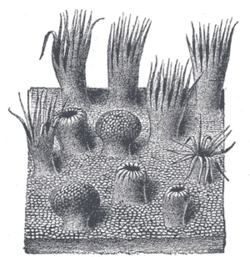Taste bud
| Taste buds | |
|---|---|
 Semidiagrammatic view of a portion of the mucous membrane of the tongue. Two fungiform papillæ are shown. On some of the filiform papillæ the epithelial prolongations stand erect, in one they are spread out, and in three they are folded in. | |
| Details | |
| Identifiers | |
| Latin | caliculus gustatorius |
| MeSH | D013650 |
| NeuroLex ID | birnlex_4101 |
| TA98 | A15.4.00.002 |
| TA2 | 7037 |
| TH | H3.04.01.0.02116, H3.04.01.0.03013 |
| FMA | 54825 |
| Anatomical terminology | |
Taste buds contain the receptors for taste. They are located around the small structures on the upper surface of the tongue, soft palate, upper esophagus and epiglottis, which are called papillae.[1] These structures are involved in detecting the five (known) elements of taste perception: salty, sour, bitter, sweet, and umami. Via small openings in the tongue epithelium, called taste pores, parts of the food dissolved in saliva come into contact with taste receptors. These are located on top of the taste receptor cells that constitute the taste buds. The taste receptor cells send information detected by clusters of various receptors and ion channels to the gustatory areas of the brain via the seventh, ninth and tenth cranial nerves.
On average, the human tongue has 2,000–8,000 taste buds.[2]
Types of papillae
The majority of taste buds on the tongue sit on raised protrusions of the tongue surface called papillae. There are four types of papillae present in the human tongue:
- Fungiform papillae - as the name suggests, these are slightly mushroom-shaped if looked at in longitudinal section. These are present mostly at the apex (tip) of the tongue, as well as at the sides. Innervated by facial nerve.
- Filiform papillae - these are thin, long papillae "V"-shaped cones that don't contain taste buds but are the most numerous. These papillae are mechanical and not involved in gustation. They are characterized by increased keratinization.
- Foliate papillae - these are ridges and grooves towards the posterior part of the roof of the mouth found on lateral margins. Innervated by facial nerve (anterior papillae) and glossopharyngeal nerve (posterior papillae).
- Circumvallate papillae - there are only about 10 to 14 of these papillae on most people, and they are present at the back of the oral part of the tongue. They are arranged in a circular-shaped row just in front of the sulcus terminalis of the tongue. They are associated with ducts of Von Ebner's glands, and are innervated by the glossopharyngeal nerve.
It is generally accepted that there are four taste sensations:
- Sweet, bitter, and savory (now sometimes called umami), which work with a signal through a G protein-coupled receptor.
- Salty and sour, which work with ion channels.
Structure of taste buds
Each taste bud is flask-like in shape, its broad base resting on the corium, and its neck opening, the gustatory pore, between the cells of the epithelium.
The bud is formed by two kinds of cells: supporting cells and gustatory cells.
The supporting (sustentacular) cells are mostly arranged like the staves of a cask, and form an outer envelope for the bud. Some, however, are found in the interior of the bud between the gustatory cells.
The gustatory (taste) cells, a chemoreceptor, occupy the central portion of the bud; they are spindle-shaped, and each possesses a large spherical nucleus near the middle of the cell.
The peripheral end of the cell terminates at the gustatory pore in a fine hair filament, the gustatory hair. Some early experimental studies (Kirk and Grills, 1992)it was shown that subjects who were genetically predisposed to baldness were found to be 78% more likely to experience taste loss sensations in 5 out of 5 taste trials.It was hypothesized that this was due to 'balding' of the tongue.
The central process passes toward the deep extremity of the bud, and there ends in single or bifurcated varicosities.
The nerve fibrils after losing their medullary sheaths enter the taste bud, and end in fine extremities between the gustatory cells; other nerve fibrils ramify between the supporting cells and terminate in fine extremities; these, however, are believed to be nerves of ordinary sensation and not gustatory.
The average life of a taste bud is 10 days.
See also
Additional images
-
schematic drawing of a taste bud
-
taste bud (nerve missing)
References
- ^ Discovery News, October 26, 2010
- ^ Encyclopædia Britannica. 2009. Encyclopædia Britannica Online.
External links
- Taste Perception: Cracking the Code
- Scientists Explore the Workings of Taste Buds from National Public Radio's Talk of the Nation, July 22, 2005
- http://kidshealth.org/kid/talk/qa/taste_buds.html For kids about taste buds!
- http://www.newser.com/story/103744/your-lungs-have-their-own-taste-buds.html
- http://en.wikipedia.org/wiki/Taste_bud#Types_of_papillae


